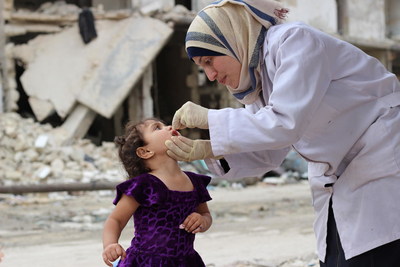Record number of children vaccinated in 2017
Record number of children vaccinated in 2017
Canada NewsWire
NEW YORK, July 16, 2018
As over 19 million children miss out on vaccinations, UNICEF and WHO call for concerted efforts to reach all children
NEW YORK, July 16, 2018 /CNW/ - A record 123 million children were immunized globally in 2017, according to data released today by the World Health Organization and UNICEF.

The data shows that:
- Nine out of every 10 children received at least one dose of diphtheria-tetanus-pertussis (DTP) vaccine in 2017, gaining protection against these deadly diseases.
- An additional 4.6 million infants were vaccinated globally in 2017 compared to 2010, due to global population growth.
- 167 countries included a second dose of measles vaccine as part of their routine vaccination schedule and 162 countries now use rubella vaccines. As a result, global coverage against measles and rubella increased from 35 per cent in 2010 to 52 per cent.
- The human papillomavirus (HPV) vaccine was introduced in 79 countries to help protect women against cervical cancer.
- Newly available vaccines are being added as part of the life-saving vaccination package – such as those to protect against meningitis, malaria and even Ebola.
Despite these successes, almost 20 million children did not receive the benefits of full immunization in 2017. Of these, almost 8 million (40 per cent) live in fragile or humanitarian settings, including countries affected by conflict. In addition, a growing share are from middle-income countries, where inequity and marginalization, particularly among the urban poor, prevent many from getting immunized.
As populations grow, more countries need to increase their investments in immunization programmes. To reach all children with much-needed vaccines, the world will need to vaccinate an estimated 20 million additional children every year with three doses of the diphtheria-tetanus-pertussis vaccine (DTP3); 45 million with a second dose of measles vaccine; and 76 million children with 3 doses of pneumococcal conjugate vaccine.
In support of these efforts, WHO and UNICEF are working to expand access to immunization by:
- Strengthening the quality, availability and use of vaccine coverage data.
- Better targeting resources.
- Planning actions at sub-national levels and
- Ensuring that vulnerable people can access vaccination services.
Notes to Editors
Since 2000, WHO and UNICEF have jointly produced national immunization coverage estimates for each of the 194 WHO Member States on an annual basis. In addition to producing the immunization coverage estimates for 2017, the WHO and UNICEF estimation process revises the entire historical series of immunization data with the latest available information. The 2017 revision covers 37 years of coverage estimates, from 1980 to 2017.
Related links
WHO/UNICEF 2017 country and regional immunization coverage data
Global Vaccine Action Plan 2012-2020
About UNICEF
UNICEF has saved more children's lives than any other humanitarian organization. We work tirelessly to help children and their families, doing whatever it takes to ensure children survive. We provide children with healthcare and immunization, clean water, nutrition and food security, education, emergency relief and more.
UNICEF is supported entirely by voluntary donations and helps children regardless of race, religion or politics. As part of the UN, we are active in over 190 countries - more than any other organization. Our determination and our reach are unparalleled. Because nowhere is too far to go to help a child survive. For more information about UNICEF, please visit www.unicef.ca. For updates, follow us on Twitter and Facebook or visit unicef.ca.
SOURCE UNICEF Canada

View original content with multimedia: http://www.newswire.ca/en/releases/archive/July2018/16/c4280.html
